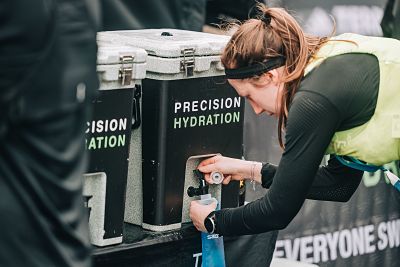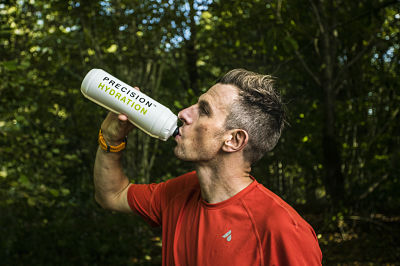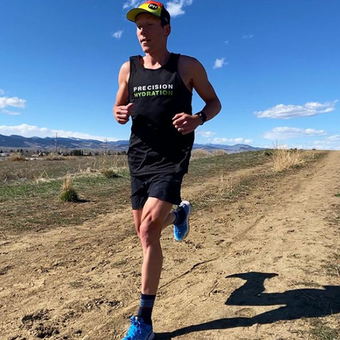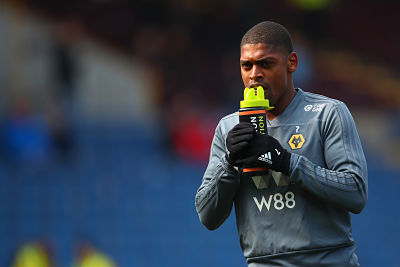Nervously drinking too much plain water before a race and then standing in the queue for the porta-potty may seem like a harmless, albeit annoying, act. But in this misguided attempt to stay well hydrated, some athletes can put themselves at risk of low blood sodium levels, otherwise known as hyponatremia.
An extreme case of overdrinking
Hyponatremia occurs when sodium and fluid in the body are out of balance. In other words, there’s either too much water or not enough sodium in your blood.
It’s a condition typically associated with clinical populations but athletes are at risk of exercise-associated hyponatremia, especially those taking part in endurance activities.
Normally, your blood sodium levels should be between 135 and 145 milliequivalents per litre (mEq/L). Hyponatremia occurs when your sodium level falls below 135 mEq/L.
In the majority of cases, hyponatremia is a result of hyperhydration or water intoxication (i.e. the overconsumption of water). Whilst few and far between, severe cases of hyponatremia can be fatal.
For example, a Sacramento woman died after taking part in a water-drinking contest - Jennifer Strange was involved in a ‘Hold Your Wee for a Wii’ contest run by a local radio station back in 2007. Trying to win her family a Nintendo Wii console, she drank close to two US gallons (nearly 7.5 litres) in just over three hours (that’s around two-and-a-half litres, or 85 fl. oz, per hour!).
Consuming such a huge volume of fluid causes a dramatic shift in the body’s electrolyte/fluid balance. The body’s cells start rapidly taking in water in a bid to reduce the amount of water in the bloodstream, which in turn causes them to swell.
When the degree of water intoxication is severe enough, this rapid influx of water can occur in the brain, making a person liable to a stroke or coma. Sadly, this is what happened to Jennifer Strange and the mother-of-three died just a few hours after leaving the radio station.
Now, this is a rare case of intentionally overriding the body’s thirst signals but it does illustrate that an extreme intake of water can be highly detrimental.
Why does overdrinking matter to athletes?
Under most circumstances, moderate overdrinking doesn’t pose a threat of hyponatremia or death.
In fact, a lot of people overdrink periodically throughout the day and the excess fluid is soon peed out. But, for athletes to overdrink before an event, particularly one of significant duration, can be harmful to performance.

There are two common ways an athlete might overdrink before an event:
- Inadvertently overdrink because their daily fluid intake has remained high, even though their training load has decreased through tapering in the days leading up to a race
- Too much nervous sipping of plain water in the time between waking up and the race start
Whatever the reason, athletes going too hard with ‘topping up’ their fluid levels and overdrinking before a race can raise the risk of exercise-associated hyponatremia.
In many athletes’ eyes, dehydration is still the one true evil which must be avoided at all costs. And it’s true, too much dehydration has proven to be detrimental to thermoregulation and our performance.
But when it comes to pre-hydration, overdoing the fluids in an attempt to stave off dehydration is counterproductive.
At the simplest level, blood is not just plain water. It’s a mixture of plasma proteins and other solutes – including electrolytes – all monitored and maintained within pretty stringent parameters.
When we overconsume just plain water, a number of things happen.
Firstly, it dilutes the blood sodium levels, decreasing our plasma osmolality. This then triggers the body to increase its urine production. The outcome is finding yourself standing in the queue for the portacabin with tens of other athletes, bursting for a pee.
You might then be thinking “no problem, I’ve drunk too much but I’ve peed it out”.
However, what you’ve also done in that process is ‘flush’ your system of both fluid AND electrolytes. This is problematic during your race because it will only take a lower fluid intake to induce low blood sodium levels.
Couple this with being a salty or heavy (or a combination of the two) sweater (i.e. another channel of sodium loss) and your risk of hyponatremia is greater again.

What the research says about pre-race overdrinking
I reached out to Dr. Stavros Kavouras, a professor of nutrition at Arizona State University and director of the Hydration Science Lab, after reading his 2019 paper on hyponatremia incidence rate at the Spartathlon, a continuous 246-km (153mi) historic ultra-distance foot race from Athens to Sparta.
The Spartathlon is a race held annually in September and attracts competitors from around the globe.
It’s earmarked as one of the toughest ultras out there; not just because of the distance, but also because of the temperatures - which can range from 5°C (41°F) to 36°C (96.8°F) - as well as the strict cut-off times and the calf-burning elevation which rises from sea level to 3,937ft (for any Brits reading this, that’s ~500ft more than climbing Snowdon, the highest mountain in Wales).
Stavros annually attends the race and has used it as an opportunity for data collection on numerous occasions. For his 2019 paper, he collected data over two years. His aim was to examine the incidence rate of hyponatremia at the race and he did this by taking blood samples from volunteers pre- and post-race as well as at the 93km checkpoint in the second year.
The research team found that 14% of the 63 ultra-runners who participated in the study started the race in a mildly hyponatremic state (i.e. blood sodium concentration <135 mEq/L).

I spoke with Stavros to get his take on the findings and the possible implications:
How much of a surprise was it to find that 14% of participants were mildly hyponatremic at the start of the race?
The observation that 14% of the participating subjects that were able to complete the race started with mild hyponatremia was a great surprise to us.
I think what probably happens is we’ve done a really great job of advertising the fact that most individuals over-consume sodium in their diet and it's well-known that a high consumption of sodium in sodium-sensitive individuals is associated with hypertension and cardiovascular disease.
However, if you’re an endurance athlete who trains and competes for hours per day in a hot environment, consuming only a small amount of sodium is not recommended because sweat-driven losses can quite often be many times higher than the recommendation for sedentary individuals.
How detrimental can starting in a hyponatremic state be to an athlete's performance?
Severe symptomatic hyponatremia not only decreases performance but is also an extremely dangerous condition. Thankfully most people do not develop the condition severely and most of the time are asymptomatic.
But, starting a race with low blood sodium levels is a predisposing factor for severe hyponatremia.
What preventative measures can ultra-endurance athletes take to ensure they don’t start in a hyponatremic state?
In general, an ultra-endurance athlete should realise that sodium (and other electrolytes) is a friend for someone who trains daily for many hours and experiences profuse sweating. Adding extra salt in food and increasing their electrolyte intake during exercise can improve electrolyte balance, health and performance.
If they can, it might be a great idea to measure electrolyte sweat content and estimate requirements precisely.
I cannot tell you how many times I have worked with athletes who experience cramps, dizziness, and more serious issues during and after exercise that have been easily fixed by increasing their electrolyte intake.
What should you drink before a race?
Before long, hot or intense training sessions or competitions, drinking a strong electrolyte drink can optimise your hydration status by acutely increasing fluid retention without consuming excessive fluids.
There’s strong evidence that additional sodium with fluids before you start sweating is effective in improving endurance performance, especially in the heat.

We’ve worked with plenty of athletes who would benefit from turning up the salt dial and dialling back on the fluid before long, hot, sweaty races.
Doing this effectively requires striking a balance with your intake so that you’re aggressive enough to drive some extra fluid retention in your bloodstream without causing gastrointestinal issues or excessive fluid build-up that makes you feel bloated and sluggish.
If you want to test a protocol and see if it improves your performance before your next race, try preloading ahead of your next long/intense training session or B-race:
- Drink 1 x PH 1500 with ~500ml (16oz) of water the evening before your activity
- Drink 1 x PH 1500 with ~500ml (16oz) of water about 90 minutes before you start. Finish your drink at least 45 minutes before you start to give your body time to fully absorb what it needs and pee out any excess
- Drink the PH 1500 in water you’d have drank anyway to ensure you don’t overdo it. The circa symbol (~) before the fluid total is key here as different athletes will drink differing amounts - for example, smaller athletes might typically drink less than larger athletes. One size won't fit all, so use some trial and error with these guidelines to help work towards what is best for you when preloading
- DON’T just drink lots of plain water in the build-up to a race
Check out our blog: ‘How to START hydrated and why that's so important’
These simple actions will help get you to the start line of your next race with your hydration in good order and hopefully keep you out of the queue for the portacabin!
